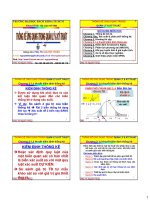Bài giảng thống kê ứng dụng trong quản lý xây dựng Lê Hoài Long
Bạn đang xem bản rút gọn của tài liệu. Xem và tải ngay bản đầy đủ của tài liệu tại đây (32.38 MB, 106 trang )
VARIABLE AND DISTRIBUTION
Part 2 – Section 3
Lecturer: Le Hoai Long (Ph.D.)
1
When the numerical value of a variable is
determined by a chance event, that variable
is called a random variable
Random variables can be discrete or
continuous.
Lecturer: Le Hoai Long (Ph.D.)
2
A probability distribution is a table or an
equation that links each possible value that a
random variable can assume with its
probability of occurrence.
Two types:
Discrete
Probability Distributions
Continuous Probability Distributions
Lecturer: Le Hoai Long (Ph.D.)
3
Discrete Probability Distributions
The probability distribution of a discrete
random variable can always be represented
by a table.
Given a probability distribution, you can find
cumulative probabilities
Lecturer: Le Hoai Long (Ph.D.)
4
Continuous Probability Distributions
The probability distribution of a continuous random
variable is represented by an equation, called the
probability density function (pdf).
All probability density functions satisfy the following
conditions:
The random variable Y is a function of X; that is, y = f(x).
The value of y is greater than or equal to zero for all
values of x.
The total area under the curve of the function is equal to
one.
Lecturer: Le Hoai Long (Ph.D.)
5
Continuous Probability Distributions
The probability that a continuous
random variable falls in the interval
between a and b is equal to the area
under the pdf curve between a and b.
There are an infinite number of
values between any two data points.
As a result, the probability that a
continuous random variable will
assume a particular value is always
zero
Lecturer: Le Hoai Long (Ph.D.)
6
Mean of a Discrete Random Variable
The mean of the discrete random variable X is
also called the expected value of X, denoted by
E(X):
E ( X ) x xi P( xi )
where xi is the value of the random variable for
outcome i, μx is the mean of random variable X,
and P(xi) is the probability that the random
variable will be outcome i.
Lecturer: Le Hoai Long (Ph.D.)
7
Median of a Discrete Random Variable
The median of a discrete random variable is
the "middle" value.
It is the value of X for which P(X < x) is
greater than or equal to 0.5 and P(X > x) is
greater than or equal to 0.5.
Lecturer: Le Hoai Long (Ph.D.)
8
Example
The number of hits made by each player is
described by the following probability distribution.
Number of hits, x
0
1
2
3
4
Probability, P(x)
0.10 0.20 0.30 0.25 0.15
What is the mean of the probability distribution?
What is the median?
Lecturer: Le Hoai Long (Ph.D.)
9
Variability of a Discrete Random Variable
The equation for computing the variance of a
discrete random variable is:
2
xi E ( X ) P( xi )
2
Lecturer: Le Hoai Long (Ph.D.)
10
Sums and Differences of Random Variables:
If X and Y are random variables, then
E ( X Y ) E ( X ) E (Y )
E ( X Y ) E ( X ) E (Y )
where E(X) is the expected value (mean) of X,
E(Y) is the expected value of Y, E(X + Y) is the
expected value of X plus Y, and E(X - Y) is the
expected value of X minus Y.
Lecturer: Le Hoai Long (Ph.D.)
11
Sums and Differences of Random Variables:
The variance of (X + Y) and the variance of (X Y) are described by the following equations
Var ( X Y ) Var ( X Y ) Var ( X ) Var (Y )
where Var(X + Y) is the variance of the sum of X
and Y, Var(X - Y) is the variance of the
difference between X and Y, Var(X) is the
variance of X, and Var(Y) is the variance of Y.
Lecturer: Le Hoai Long (Ph.D.)
12
Independence of Random Variables
If two random variables, X and Y, are
independent, they satisfy the following
conditions (either one).
P ( x y ) P ( x) for all values of X and Y
P ( x y ) P( x) P( y ) for all values of X and Y
Lecturer: Le Hoai Long (Ph.D.)
13
Considering only these types:
Binomial
distribution
Negative binomial distribution
Geometric distribution
Multinomial distribution
Hypergeometric distribution
Lecturer: Le Hoai Long (Ph.D.)
14
BINOMIAL DISTRIBUTION
Lecturer: Le Hoai Long (Ph.D.)
15
Binomial Experiment
The
experiment consists of n
repeated trials.
Each trial can result in just
two possible outcomes
(success and failure).
The probability of success,
denoted by p, is the same
on every trial.
The trials are independent
Lecturer: Le Hoai Long (Ph.D.)
16
Notation
x: The number of successes that result from the binomial
experiment.
n: The number of trials in the binomial experiment.
p: The probability of success on an individual trial.
q: The probability of failure on an individual trial.
f(x): Binomial probability function
nCx: The number of combinations of n things, taken x at a
time.
n!
n Cx
x!(n x)!
Lecturer: Le Hoai Long (Ph.D.)
17
Binomial Distribution
A binomial random variable is the number
of successes x in n repeated trials of a
binomial experiment.
The probability distribution of a binomial
random variable is called a binomial
distribution (also known as a Bernoulli
distribution).
Lecturer: Le Hoai Long (Ph.D.)
18
The binomial distribution has the following
properties:
The
mean of the distribution (μx) is equal to np .
The variance (σ2x) is np(1 - p).
The standard deviation is σx
It is generally agreed that if the ratio of
sample size to population size is no more
than 0.05, the trials without replacement are
essentially independent.
Lecturer: Le Hoai Long (Ph.D.)
19
Binomial Probability
The binomial probability refers to the
probability that a binomial experiment results
in exactly x successes. Suppose a binomial
experiment consists of n trials and results in
x successes. If the probability of success on
an individual trial is P, then the binomial
probability is:
x
n x
f ( x) n C x p (1 p)
Lecturer: Le Hoai Long (Ph.D.)
20
Cumulative Binomial Probability
A cumulative binomial probability refers to
the probability that the binomial random
variable falls within a specified range (e.g., is
greater than or equal to a stated lower limit
and less than or equal to a stated upper
limit).
x
F ( a) f ( x) n C x p (1 p )
xa
n x
xa
Lecturer: Le Hoai Long (Ph.D.)
21
Lecturer: Le Hoai Long (Ph.D.)
22
Example: Flooding of a road.
Suppose a road is flooded with probability p =
0.1 during a year and not more than one flood
occurs during a year.
What is the probability that it will be flooded at
least once during a 5-year period?
What is the probability that it will be flooded
twice during a 5-year period?
What is the probability distribution?
Lecturer: Le Hoai Long (Ph.D.)
23
Applied: Lot-acceptance sampling:
- A quality control procedure
- A standard is set and if the products meet
this standard, then they are accepted
- A lot is a large number of the same items so
impossible to test all
- Therefore, a much smaller random sample is
taken from each lot to test
Lecturer: Le Hoai Long (Ph.D.)
24
Applied: Lot-acceptance sampling
-
For a given sampling plan with parameters n
(sample size) and r (acceptance number, e.g
defective items in sample), the probability that a
lot will be accepted is Pr. (with p is the expected
proportion in the lot)
Pr P( x r ) F ( r )
n!
x
n x
p (1 p)
x r x!( n x )!
Lecturer: Le Hoai Long (Ph.D.)
25









